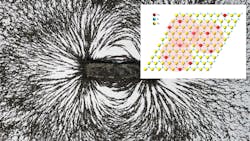Researchers at the Dept. of Energy’s Lawrence Berkeley National Laboratory and UC Berkeley have developed a one-atom-thick magnet that operates at room temperature. It could lead to new applications in computing and electronics such as high-density, compact spintronic memories and new tools for studying quantum physics.
The team fabricated the new magnet, called a cobalt-doped van der Waals zinc-oxide magnet, from a solution of graphene oxide, zinc, and cobalt. The mixture was baked for a few hours in an oven, which turned the mixture into a single atomic layer of zinc-oxide with some cobalt atoms sandwiched between layers of graphene.
Finally, the graphene was burned away, leaving behind just the magnet, a single layer of chemically stable cobalt-doped zinc-oxide that can be bent into almost any shape without breaking and with one millionth the thickness of a piece of paper. The manufacturing process should be scalable for mass production at lower costs.
The thin magnets also work at room temperature, as well as temperatures up to 212°F. Until now, ultra-thin magnets lost their magnetism at room temperature or above.
The researchers also discovered that the zinc-oxide layer became weakly magnetic with a 5 to 6% concentration of cobalt atoms. Increasing the concentration of cobalt atoms to about 12% created much stronger magnets.
Until this new magnet was developed, the magnetic components of memory devices used magnetic thin films. But these films are hundreds or thousands of atoms thick. For decades, researchers have tried to make thinner and smaller magnets that will let data be stored at much higher densities.

